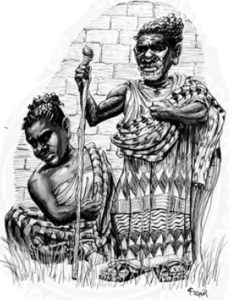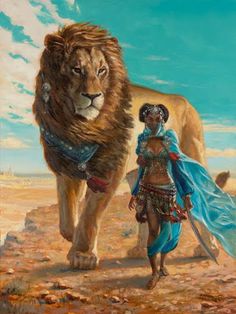Gnomes–the also-rans of Dungeons and Dragons. Ever since being introduced to them in AD&D’s Monster Manual, it’s been hard for me to know how to distinguish them. They aren’t quite dwarves, aren’t quite haflings and Gygax and the writers at TSR never really gave them their own identity. The Dragonlance material had it so they’d be gaslight fantasy or proto-industrial, quasi-steampunk inventors but that was about the same time I had weened my own campaign off science fantasy. And besides, aside from humans, dwarves always struck me as the ones who’d betray magic and go for science and technology. Anyway, until recently, no players in my game ever built a gnome characters–probably because gnomes are so lackluster.
 Luckily along came Atlas Games truly wonderful campaign background Nyambe–cultures that weren’t just another dull, quasi-European, medieval fantasy pastiche. Since the early aughts I’ve been steadily incorporating a lot of the material from Nyambe into my campaign. It’s helped me to give historical and cultural grounding where I had none. Case in point: gnomes.
Luckily along came Atlas Games truly wonderful campaign background Nyambe–cultures that weren’t just another dull, quasi-European, medieval fantasy pastiche. Since the early aughts I’ve been steadily incorporating a lot of the material from Nyambe into my campaign. It’s helped me to give historical and cultural grounding where I had none. Case in point: gnomes.
In Udra gnomes are very rare, far rarer than halflings, dwarves and elves. Out of Udra’s cultures, gnomes have probably remained the truest to their Nyambe roots.
In Nyambe, gnomes are known as “kitunusi” and practice a culture of stoicism, emotional reticence and and detachment, they’re a bit like Trek’s Vulcans or, perhaps, Buddhists or Spartans. They have emotions but it is considered social weakness and deeply embarrassing to share these publicly and definitely not with strangers. They tend to be very strongly associated with illusionist and shadow magic or earth elemental forces. For ancient historical reasons, dating all the way back to betrayals in Nyambe, Udra’s gnomes are often strongly suspicious of dwarves.
 Their extreme stoicism leads to a very spartan artistic culture. There food is nutritious but very bland–think of the poi of Hawaii. Their music is dull, droning and occasionally oddly disturbing. They’ve produced no poetry and literature of note save some strange, incomprehensible parables that are a bit like Zen koans. Only in two areas does their culture truly flower: textiles and architecture.
Their extreme stoicism leads to a very spartan artistic culture. There food is nutritious but very bland–think of the poi of Hawaii. Their music is dull, droning and occasionally oddly disturbing. They’ve produced no poetry and literature of note save some strange, incomprehensible parables that are a bit like Zen koans. Only in two areas does their culture truly flower: textiles and architecture.
They are extraordinarily skilled in textile arts and weaving of all sorts, their cloth is the most beautiful in all Udra, easily surpassing that of elf-make, and fetches the highest prices. However this is because gnomes consider uniforms and clothing as part of their complicated caste system. Almost all gnomes tend to wear elaborate and beautiful uniforms of a sort. While this suppresses their own individuality, at a glance, any other gnome can look at a comrade’s raiment and know her family, place of birth, skills and social standing. It’s a bit like heraldry. As such gnomes don’t give their fabrics or tailoring away lightly. They do sell it to outsiders but be expected to pay a lot. For gnome, it is considered highly dishonorable to have one’s clothing, one’s uniform stolen. Gnomes who violate their own dress codes are considered fools, criminals and bordering on insane.
The other area Nyambe’s kitunusi gnomes excel at their elaborate sunken architecture, usually carved into basaltic or other forms of volcanic rock. Think of places like Petra or the rock hewn churches of Ethopia. As yet, there is no major gnome settlement in Udra. For the last few centuries, they’ve been too few and they’ve been content to blend into the bustle of human settlements. Udra has not seen gnomish architecture.
In all other ways Udra’s gnomes conform to the guidelines on page 39 of the Nyambe source book. They’re favored class is rogue, not bard. The material on page 17 of the 3.5 D&D Player’s Handbook should be ignored.
